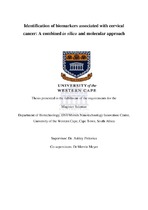| dc.description.abstract | Cervical cancer is the leading cause of cancer mortality among black women in South Africa. It is estimated that this disease kills approximately 8 women in South Africa every day. Cervical cancer is caused by the human papillomavirus (HPV) with the most common screening method for cervical cancer being Papanicolaou (Pap) smear, test amongst others. However, less than 20% of South African women go for these tests. There are several reasons why women do not go for these tests but the invasiveness of the test is one of the major causes for the low rate of screening. Lateral flow devices offer medical diagnosis at the point- of-care, allowing for the quick initiation of the appropriate therapeutic response. These tests are more cost-effective for the healthcare delivery industry, and can potentially be used by patients to self-test in the privacy of their homes and allow them to make informed decisions about their health. Therefore, the aim of this study was to use computational methods to identify serum biomarkers for cervical cancer that can be used to develop a point-of-care diagnostic device for cervical cancer. An in silico approach was used to identify genes implicated in the initiation and development of cervical cancer. Several bioinformatics tools were employed to extract a list of genes from publicly available cancer repositories. Multiple gene enrichment analysis tools were employed to analyze the selected candidate genes. Through this pipeline, ~28190 genes were identified from the various databases and were further refined to only 10 genes. The 10 genes were identified as potential cervical cancer biomarkers. A subcellular compartmentalization analysis clustered the proteins encoded by these genes as cell surface, secretory granules and extracellular space/matrix proteins. The selected candidate genes were predicted to be specific for cervical cancer tissue in a cancer tissue specificity meta-analysis study. The expression levels of the candidate genes were compared relative to each other and a graph constructed using gene expression data generated by GeneHub-GEPIS and TiGER databases. Further gene enrichment analysis was performed such as protein-protein interactions, transcription factor analysis, pathway analysis and co-expression analysis, with 9 out of the10 of the candidate genes showing co-expression. A gene expression analysis done on cervical cancer cell lines, other cancer cell lines and normal fibroblast cell line revealed differential expression of the candidate genes. Three candidate genes were significantly expressed in cervical cancer, while the seven remaining genes showed over expression in other cancer types. The study serves as basis for future investigations to diagnosis of cervical cancer, as well as for cancers. Thus, they could also serve as potential drug targets for cancer therapeutics and diagnostics. | en_US |

